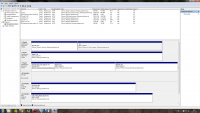Hello
I have 2 SSDs in my computer (identical TS128GSSD370).
I would like to create one common system partition from these drives, and here is the question, how?
RAID or a combination of dynamic drives?
I've read a lot about dynamic disks, but sometimes conflicting information, and I don't know if I could use them in my case.
I have doubts, because at the moment I have a system installed on one SSD (I have a second one empty, just added) and I don't know if it is possible to extend the system partition with the empty space from the second drive. Some people write that it can, others that it can't, so what's it like in the end?
As for RAID, maybe that would be a better solution?
Only in that case, what about the TRIM function? I read somewhere that in arrays this function does not work.
What do you recommend, and how to do it (assuming no data loss on the disk)?
Disk configuration attached. Disk0 and Disk1 are the disks in question.
Regards and looking forward to your reply
Edit:
My motherboard is an Asrock P67 PRO3 B3, and I've just read that the P67 chipset does not support TRIM unless I upload a non-original modified BIOS.
I have 2 SSDs in my computer (identical TS128GSSD370).
I would like to create one common system partition from these drives, and here is the question, how?
RAID or a combination of dynamic drives?
I've read a lot about dynamic disks, but sometimes conflicting information, and I don't know if I could use them in my case.
I have doubts, because at the moment I have a system installed on one SSD (I have a second one empty, just added) and I don't know if it is possible to extend the system partition with the empty space from the second drive. Some people write that it can, others that it can't, so what's it like in the end?
As for RAID, maybe that would be a better solution?
Only in that case, what about the TRIM function? I read somewhere that in arrays this function does not work.
What do you recommend, and how to do it (assuming no data loss on the disk)?
Disk configuration attached. Disk0 and Disk1 are the disks in question.
Regards and looking forward to your reply
Edit:
My motherboard is an Asrock P67 PRO3 B3, and I've just read that the P67 chipset does not support TRIM unless I upload a non-original modified BIOS.



